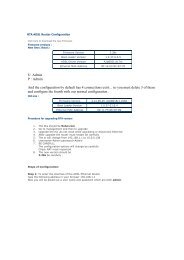Concealed Intentions- JLAC-.pdf
Concealed Intentions- JLAC-.pdf
Concealed Intentions- JLAC-.pdf
You also want an ePaper? Increase the reach of your titles
YUMPU automatically turns print PDFs into web optimized ePapers that Google loves.
II. Violations of Human Rights and International<br />
Humanitarian Law<br />
Israel’s obligations as the Occupying Power in the oPt are set out in two provisions of international humanitarian law<br />
(“IHL”): the Regulations Annexed to the Fourth Hague Convention Respecting the Laws and Customs of War on Land of<br />
1907 (“Hague Regulations”), and the Fourth Geneva Convention Concerning the Protection of Civilian Persons in Time<br />
of War of 1949 (“IVGC”). Israel has a duty to respect and apply these international humanitarian provisions and ensure<br />
the welfare of the occupied Palestinian population. The IVGC imposes very precise obligations on an occupying<br />
power’s duties vis-à-vis the population it occupies, such as respecting the welfare of the occupied population,<br />
prohibiting collective punishment and population transfer, respect of private property, freedom of religion, and<br />
facilitating institutions devoted to education of children. 100 These provisions were reaffirmed by the United Nations<br />
(“UN”) in UN Security Council Resolution 799: “[The General Assembly] reaffirms the applicability of the Fourth Geneva<br />
Convention of 12 August 1949 to all the Palestinian territories occupied by Israel since 1967, including Jerusalem,<br />
and affirms that deportation of civilians constitutes a contravention of its obligations under the Convention.” 101 As a<br />
signatory to the IVGC, and having accepted the applicability of the Hague Regulations, Israel has a duty to abide by<br />
the provisions set out in both bodies of law and cannot continue to act with impunity in the oPt.<br />
In addition to IHL, Israel is also bound by the provisions outlined in international human rights law (“IHRL”). Human<br />
rights are understood to be “those minimal rights that individuals need to have against the state or other public<br />
authority by virtue of being members of the human family, irrespective of any other consideration.” 102 Israel denies the<br />
applicability of IHRL in the oPt on the basis that the conventions only apply to a government and its people. 103 Most of<br />
the Universal Declaration of Human Rights (“UDHR”), however, in addition to provisions in other international human<br />
rights conventions such as the International Covenant on Civil and Political Rights (“ICCPR”) and the International<br />
Covenant on Economic, Social and Cultural Rights (“ICESCR”), reflect customary international law, and are therefore<br />
applicable to Israel. 104 The applicability of international human rights standards in the OPT was also upheld in the<br />
2004 ICJ Advisory Opinion on the Annexation Wall, wherein the Court observed that Israel is bound by the provisions<br />
of the ICCPR and the ICESCR inasmuch as the oPt have been subject to Israel’s territorial jurisdiction for over thirtyseven<br />
years. 105<br />
This chapter will explore Israel’s gross violations of IHRL and IHL through its discriminatory zoning and planning<br />
policies.<br />
a. Violation of Housing, Land and Property Rights<br />
Various UN human rights treaties consistently highlight the issue of land rights. 106 Through its practice of home<br />
demolitions, evictions, forced displacement and land appropriation, Israel directly violates the right to adequate<br />
housing and the right of property. Theoretically, land-planning policies must respect housing, land and property<br />
100 Convention (IV) Relative to the Protection of Civilian Persons in Time of War. Part III. Status and Treatment of Protected Persons. Geneva, 12 August 1949.<br />
Viewed 16/2/2011. See for instance Article 27: “Protected persons are entitled, in all circumstances, to respect for their persons, their<br />
honor, their family rights, their religious convictions and practices, and their manners and customs. They shall at all times be humanely treated, and shall be<br />
protected especially against all acts of violence or threats thereof and against insults and public curiosity. [...]”<br />
101 United Nations Security Council Resolution 799, 1992. The Avalon Project at Yale Law School.<br />
<br />
102 Sanjay K. Roy, Refugees and Human Rights: The Case of Refugees in Eastern and North-Eastern States of India, pp. 17-62 (New Delhi: Rawat Publications, 2001),<br />
p. 42.<br />
103 Report of the UN Secretary-General prepared pursuant to General Assembly Resolution ES-10/13, November 2003.<br />
104 Al-Haq, Waiting for Justice, Annual Report 2004, p. 43.<br />
105 Advisory Opinion of the International Court of Justice, op. cit, para. 102-113.<br />
106 Six of the UN treaty monitoring bodies have addressed land issues in their General Comments/ Recommendations, and review of State Party reports.<br />
Additionally, land issues have been addressed by Special Rapporteurs, especially the Special Rapporteur on the Right to Food, the Special Rapporteur on<br />
Adequate Housing, the Special Rapporteur on the on the Human Rights of Internally Displaced Persons, and the Special Rapporteur on the Situation in the<br />
oPt.<br />
25





